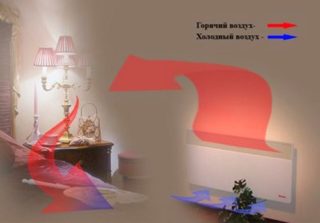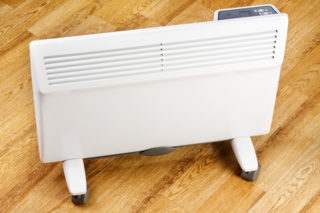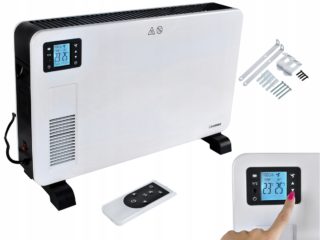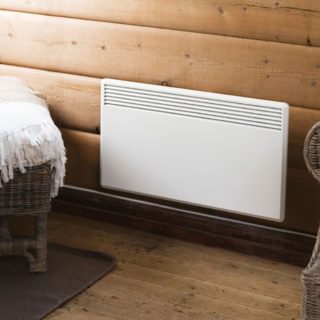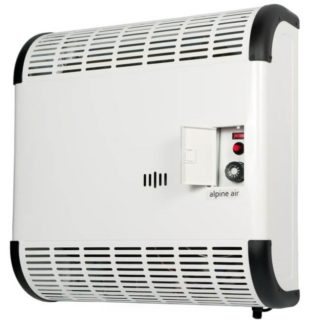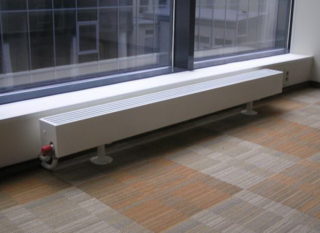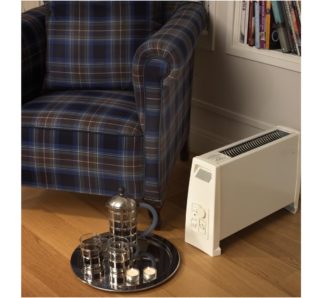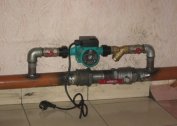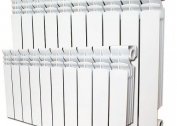The advantages of convectors as home heating make it possible to use them as a primary or secondary heat source. Depending on the chosen model, the convector type heater can be mounted to the wall or mounted on the floor, which is convenient if the room is not always required to be heated. Convection heater can be connected to the mains or gas main.
The principle of operation of convector heaters
According to the laws of physics, cold air is heavier, so it is located below. The principle of convection is to pick up the cold air masses from below, heat them inside the unit and move them to the upper part, from where warm air is blown up. This is how the room is heated. The flow moves continuously, so after 3 to 4 minutes the room becomes warm. Further, the air masses are again cooled and fall down, where they again fall into the lower holes of the convector.
The device, depending on the model, can be transported and turned on, for example, in the country. For this, electric convection units are more suitable.
Devices of this type can be turned on in a bathroom or other rooms with high humidity. It is safe, as they are reliably protected from moisture. The case does not heat up much - if there are small children in the room, they will not get burns if they touch parts of the device.
Modern convectors can be configured to work in a certain mode. Settings are saved if a power outage occurs and the device continues to operate.
Pros and Cons of Home Use
There are a lot of positive points, because of which it is worth buying a convector in a house or apartment:
- You do not need to obtain permits for use if this is a conventional electrical device.
- Easy installation. The convector on the legs is installed in the right place and plugs into the outlet. There are wheels for moving.
- Adjustable temperature. Some models have built-in sensors that support the desired mode of operation.
- Silent - can be turned on around the clock.
- Compact dimensions allow convectors to be installed in small rooms.
- Do not burn oxygen, since the temperature inside the heating element does not exceed 65 degrees.
- Economical. They cost cheaper than oil radiators, while the efficiency is much higher. When no one is home, the heater can be set to a lower temperature.
- Low cost allows you to install multiple devices in one room, if necessary.
- The devices are fireproof and have protection against overheating.
- You can purchase a convector heater with a protective screen with an adjustable air flow directed to a specific area.
You can choose the units according to the color of the case to match the design of the room. There are also various models. Some of them can be installed in the floor so that they do not take up space, but such units are mounted during rough repairs. The rest are installed after finishing the walls.
The disadvantages of this type of heating are few. High power devices will require more power consumption. The inconvenience may be associated with the installation of floor convectors, the grate of which is on the same level with the coating - garbage will fall into the unit.If the room is dusty, dust particles will constantly float in the air due to circulation. The apartment will have to do wet cleaning more often.
Once a year, the unit must be cleaned of the dust accumulated inside.
Additional equipment can be connected to this type of devices:
- humidifier;
- timer;
- thermostat for precise temperature control;
- remote control to turn on appliances remotely.
Optional equipment is usually not included with the device. If necessary, buy it separately.
Installation types
By the type of installation, it is possible to distinguish mobile heaters that can be transported, wall and floor. The mobile unit on castors can be used as additional heating. For example, in a bathroom where you need to keep the air dry so that mold does not start, or in a children's room in winter. It can also be taken for a weekend to the cottage - while the stove is burning up, the convector heats the room and creates a cozy atmosphere. The floor heater can be installed anywhere. The only limitation is the length of the cord.
Wall mounted
A wall-mounted convector heater is most often hung under a window to create a screen of warm air. This is especially true if the windows are panoramic and heat loss occurs through them. The principle is the same as with conventional water batteries, only they radiate heat, and the convector sets the air in motion.
Models of wall convectors are various. Among them there are low - up to 20 cm in height, but very long - up to 2.5 m. For panoramic windows, under which there is very little space for installing heating devices, there are models installed directly on the floor.
Floor recessed
During the planning and pouring of concrete floors, floor convection systems can be installed. After all the work, only the grill will be visible, through which cold air is sucked in and warm air comes out. Such models are suitable for large rooms - they can be mounted around the perimeter, and the grilles can be matched to the floor covering in order to preserve the design. Lattices are the main element of the floor convector, as the rest of it is hidden in the floor. Lattices can be made of any material - wood, iron, plastic.
Built-in appliances can not be installed everywhere. Usually, installation is planned at the construction stage, since for such a model, communications should be laid in the floor to supply hot water to the heating system.
Built-in convectors are usually equipped with fans to speed up air circulation and heat the room faster.
Varieties of convectors
Depending on which coolant is connected to the heating system, you can choose a water or gas convector. The internal arrangement of the devices will be slightly different, but the principle is the same: the heat carrier heats the elements inside the device through which air passes and collects heat, then leaves the heater and heats the room.
Gas
Inside the convector is a burner that heats the gas. The device has an air intake, which at one end is on the street. Oxygen is needed to maintain combustion. A chimney is needed to remove combustion products from the combustion chamber.
Gas convection heating of the house does not need water, it is safe, since the combustion chamber is completely insulated.
The disadvantages of gas appliances are as follows:
- To install a convector, you need to get permission in the gas industry. The problem may arise due to the construction of the house and the inability to equip the chimney.
- When heated with gas, the temperature of the case is above 60 degrees, so the process of thermal decomposition of dust particles that settle on furniture and other interior items begins.
It is more profitable to use gas convectors in rooms that are not intended for permanent residence or as additional heating.
Water
Water convectors can be installed in autonomous and central heating systems. They are reliable and durable, and also able to transfer up to 95% of the generated heat.
According to the type of installation, water heaters can be floor, baseboards, wall, floor, basement. Connect to pipes of any diameter through a series of adapters. The case temperature usually does not exceed 30 degrees, so young children will not be able to get a burn by touching the device.
Water convectors, built into the floor, are planned during the construction phase of the house, as niches are built under them and pipes are installed. Once the floor is finished, it will be impossible to install such models.
Water wall heating convectors are usually placed under windows to reduce the flow of cold air if the glass unit is single-chamber.
If you need to hide the heating system, you can buy built-in models. They are mounted in special niches in the wall or mounted on furniture.
Of the benefits:
- Light weight, which allows you to install devices on plasterboard partitions.
- Compact thanks to the slim body.
- You can adjust and adjust the temperature.
- There are models with one or two heat exchangers.
Water heaters are the most common among similar models, therefore they are available in a different design, which allows them to be mounted in rooms of any style and color scheme.
Electric
The safest are electric convectors. Most manufacturers produce devices with the highest degree of electrical protection: not a single wire is in contact with the housing. Thanks to this, the models can be operated without grounding.
The temperatures of heating the water are low enough so that there is no burning of oxygen and the dust does not decay into microparticles, which badly affect the state of the human respiratory system. Low heating temperatures are compensated by the volume of heating elements.
In any heater, fuel consumption occurs. In this case, this is electricity, for which you do not need to go far or go, such as for wood or gasoline. Electricity consumption can be large if the premises are rather large in area or the temperature in the winter season drops significantly below zero degrees. To save, it is advisable to install double-glazed windows with argon spraying, which prevents the release of heat.
Infrared
If a typical convector heats the air by circulating it through a heat exchanger, then the principle of infrared heating at home is different. The device heats the surrounding objects with infrared radiation, and the objects give off heat to the surrounding space. In this regard, it is desirable that the device be installed in a place where its radiation on objects or walls will be maximum. Then the heat transfer will be high.
It is better to use infrared heaters as an additional source of heat, since when you turn it off, its room cools quickly.
In the infrared series there are only two models of heaters - floor and wall. They need a working outlet with high-quality wiring. Extension cords are undesirable if the device is operating at full power.
How to choose a convector type heater
First of all, it is necessary to calculate the power of the heater based on the area of the room. For electrical appliances it is 100 W / sq.m. The height of the ceilings is taken into account. If it is higher than 2.4 meters, the power is increased by 2 times.Thus, for proper heating of an area of 20 square meters. m will need a power of 2 kW.
If the house has alternative heat sources, and the convector is used as an addition, you can limit yourself to a power that is 2 times less than the calculated one.
The type of thermostat affects the cost of the device. Electric adds about 30% to the price. Particular attention should be paid to the heater, since this is the main structural element that affects its durability. Qualitative tena serve more than 15 years. They are made of steel, which withstands the temperature of the filament for a long time.
The moisture protection index parameter must be at least IP 21, but if the device is periodically installed in the bathroom, an index of at least IP 24 and above is needed.
If you need to direct a warm stream of air to a certain point in the room, you must choose models with a protective screen - stationary or portable.
In an apartment where there are young children, it is necessary to purchase a rollover sensor. If someone accidentally pushes the device, the sensor will automatically disconnect it from the mains.
In cold rooms, frost protection can be used. This is a temperature sensor that automatically turns on the convector if the air temperature drops below a certain level, which you can configure yourself.
Installation Features
Electric convectors do not require special building skills. To install the wall model, you need to choose a place, attach the brackets that come with the equipment, and hang the device. It is important that the cord can reach the outlet.
For gas equipment, you must first obtain a permit. The installation of devices involved gas masters. After completion of work, a document is issued confirming the right to operate a gas convector.
Floor models can be installed in an apartment or a private house. Most developers plan to install built-in convectors in advance, and apartment buyers are notified of this.
Water convectors are mounted on a wall or floor, where plastic pipes are laid through which hot water circulates from a gas or electric boiler.
